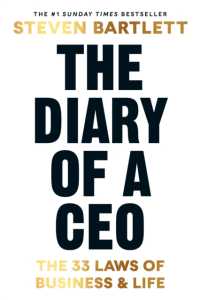- ホーム
- > 洋書
- > 英文書
- > Politics / International Relations
Full Description
This handbook presents a comprehensive view of the current theory and research surrounding political elites, which is now a pivotal subject for academic study and public discourse. In 40 chapters by leading scholars, it displays the field's richness and diversity. The handbook is organized in six sections, each introduced by a co-editor, focusing on theories about political elites, methods for studying them, their main structural and behavioral patterns worldwide, the differentiation and integration of political elite sectors, elite attributes and resources, and the dilemmas of political elites in this century. Forty years since Robert Putnam's landmark Comparative Study of Political Elites, this handbook is an indispensable resource for scholars and students engaged in the study of this vibrant field.
Contents
Introduction to the Palgrave Handbook of Political Elites; Heinrich Best and John Higley.- Chapter 1: Introduction to Section I: The Development of Elite Theory; Jan Pakulski.- Chapter 2: Classical Elite Theory: Pareto and Weber; Jan Pakulski.- Chapter 3: Continuities and Discontinuities in Elite Theory; John Higley.- Chapter 4: Political Elites and Democracy; András Körösényi.- Chapter 5: Theory-Based Typologies of Political Elites; Ursula Hoffmann-Lange.- Chapter 6: Introduction to Section II: Research Methods for Studying Elites; Elena Semenova.- Chapter 7: Methods of Elite Identification; Ursula Hoffmann-Lange.- Chapter 8: Surveying & Observing Political Elites; Juan Rodríguez-Teruel and Jean-Pascal Daloz.- Chapter 9: Temporal Methods in Political Elite Studies; Sebastian Jäckle and Matthew Kerby.- Chapter 10: Analyses of Elite Networks; Franziska Barbara Keller.- Chapter 11: Introduction to Section III: Patterns of Political Elites; John Higley.- Chapter 12: Pre-Modern Power Elites: Princes, Courts, Intermediaries; Jeroen Duindam.- Chapter 13: Political Elites in the Middle East and North Africa; Clement Henry.- Chapter 14: Political Elites in South Asia; Philip Oldenburg.- Chapter 15: Political Elites in Southeast Asia; William Case.- Chapter 16: Political Elites in Sub-Saharan Africa; Jean-Pascal Daloz.- Chapter 17: Political Elites in Latin America; Cristóbal Rovira Kaltwasser.- Chapter 18: The Political Elite in Post-Soviet Russia; Peter Rutland.- Chapter 19: The PoliticalElite in China: A Dynamic Balance between Integration and Differentiation; Cheng Li.- Chapter 20: Political Elites in the West; John Higley.- Chapter 21: Introduction to Section IV: Elite sectors: Differentiation and Integration; Heinrich Best.- Chapter 22: Representative Elites; Heinrich Best and Lars Vogel.- Chapter 23: Executive Elites; Luca Verzichelli.- Chapter 24: Non-Elected Political Elites in EU; Niilo Kauppi and Mikael Rask Madsen.- Chapter 25: Economic Elites; Michael Hartmann.- Chapter 26: Media Elites; Eva Mayerhöffer & Barbara Pfetsch.- Chapter 27: Models of Elite Integration; Fredrik Engelstad.- Chapter 28: Introduction to Section V: Elite Attributes and Resources; Jean-Pascal Daloz & Ursula Hoffmann-Lange.- Chapter 29: The Personality Attributes of Political Elites; Gian Vittorio Caprara & Jo Silvester.- Chapter 30: Political and Social Backgrounds of Political Elites; Daniel Gaxie.- Chapter 31: Political Elites and Symbolic Superiority; Jean-Pascal Daloz.- Chapter 32: Norms and Orientations of Political Elites; Bernhard Weßels.- Chapter 33: Power Networks; David Knoke.- Chapter 34: Introduction to Section VI: Elite Dynamics and Dilemmas; Maurizio Cotta.- Chapter 35: Elite Circulation and Stability; Luca Verzichelli.- Chapter 36: Democratization: The Role of Elites; Philippe C. Schmitter.- Chapter 37: Sub-National Political Elites; Filippo Tronconi.- Chapter 38: Elites or Leadership? Opposite or Complementary Paradigms?; Jean Blondel.- Chapter 39: Political Elites Beyond The Nation State; Maurizio Cotta.








